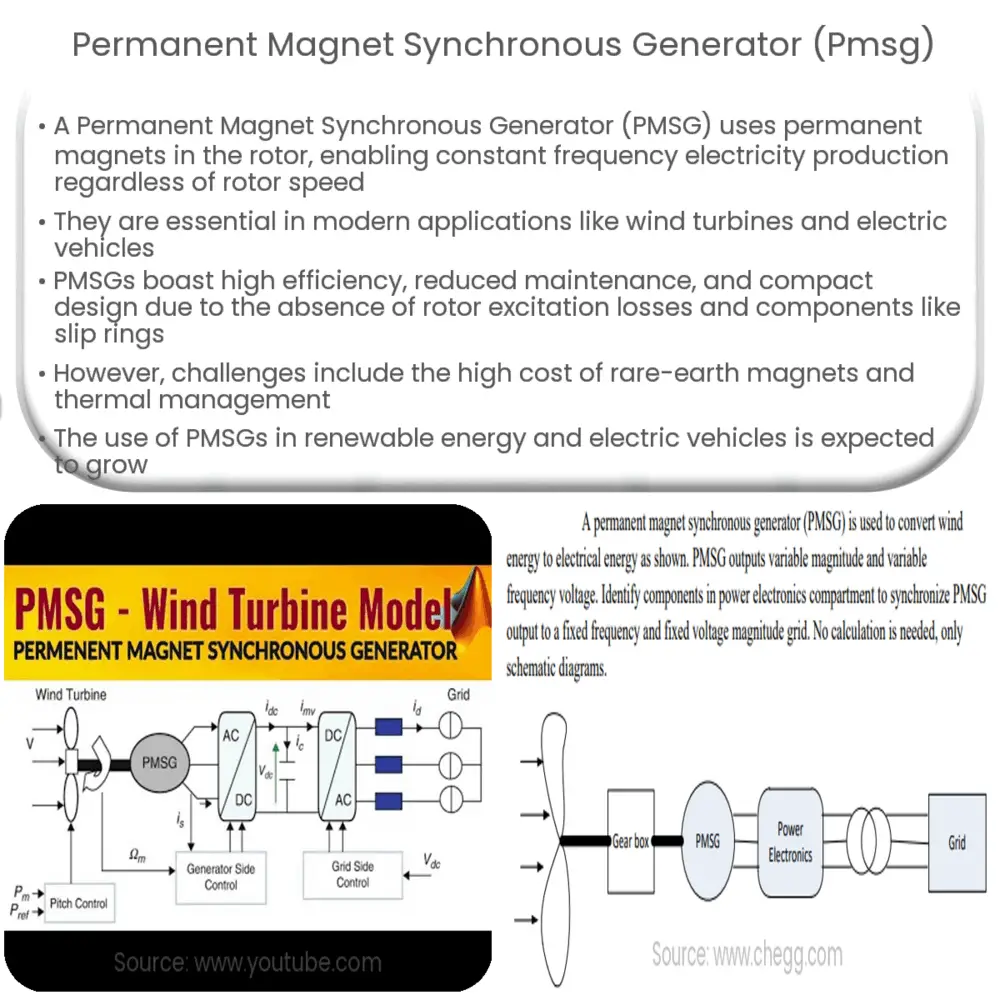Explore the working principle, benefits, and applications of Permanent Magnet Synchronous Generators (PMSGs), key in renewable energy and EV technology.

Introduction to Permanent Magnet Synchronous Generator (PMSG)
A Permanent Magnet Synchronous Generator (PMSG) is a type of electrical generator that uses permanent magnets instead of traditional field windings in the rotor. This design enables PMSG to produce electricity at a constant frequency, regardless of the rotor’s speed. This feature makes PMSG a crucial component in various modern applications, such as wind turbines, electric vehicles, and more.
Working Principle of PMSG
The operation of a PMSG is based on Faraday’s law of electromagnetic induction. When the rotor, embedded with permanent magnets, rotates, it creates a moving magnetic field. This motion induces an electromotive force (EMF) in the stator windings, generating electricity. Notably, the produced EMF and, consequently, the output frequency directly depend on the rotor’s rotational speed.
- Permanent Magnets: The magnets provide a steady magnetic field, removing the need for an external power source to excite the generator.
- Stator: It consists of three-phase windings where the output voltage is induced.
- Rotor: Unlike conventional synchronous generators, the rotor in a PMSG has no windings, slip rings, or brushes, reducing maintenance requirements and enhancing reliability.
Benefits of PMSG
PMSG offers several advantages over traditional electric generators. It provides high efficiency, as there are no losses associated with rotor excitation. The absence of slip rings and brushes ensures low maintenance and high reliability. Additionally, PMSGs are more compact and lighter, making them ideal for applications where space and weight are critical considerations.
Applications of PMSG
The versatile characteristics of PMSG have made them a preferred choice for many applications. Here are some key areas where PMSGs are commonly used:
- Wind Energy Systems: The use of PMSGs in wind turbines significantly enhances their efficiency and reliability.
- Electric Vehicles: In electric vehicles, PMSGs contribute to higher efficiency, better torque control, and size reduction.
- Marine Propulsion: PMSGs are used in marine propulsion systems due to their high torque density, efficiency, and compact size.
Challenges and Solutions
Despite its numerous advantages, the use of PMSGs is not without challenges. One notable issue is the cost of the permanent magnets, which are made of rare-earth materials. These materials are expensive and often subjected to volatile market conditions. However, advancements in material science are continuously seeking alternatives to reduce dependency on rare-earth elements.
Another challenge is the thermal management of PMSGs. Permanent magnets can lose their magnetism if heated beyond a certain threshold, known as the Curie temperature. To counter this, effective cooling mechanisms are incorporated into the design of PMSGs.
Future Trends
As we move towards more sustainable and efficient energy systems, the role of PMSGs is likely to become even more significant. Their application in renewable energy systems, particularly in wind and tidal energy conversion, is set to grow. Furthermore, with the continued push towards electrification in the automotive industry, the demand for PMSGs in electric vehicles is expected to increase.
Conclusion
In conclusion, Permanent Magnet Synchronous Generators (PMSGs) offer an efficient, reliable, and compact solution for electricity generation in a variety of applications. Despite some challenges, including the cost of permanent magnets and thermal management, continued technological advancements are helping overcome these hurdles. With their vital role in renewable energy systems and the electrification of transport, PMSGs will undoubtedly continue to be a key component in our journey towards a more sustainable and efficient future.

